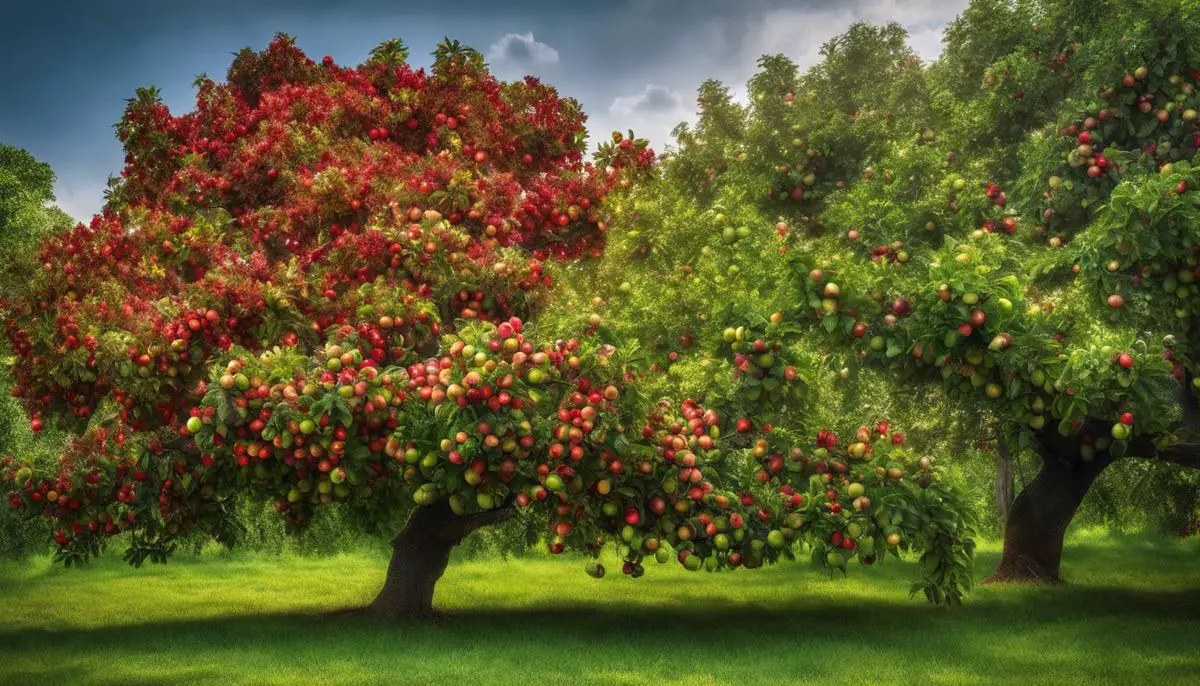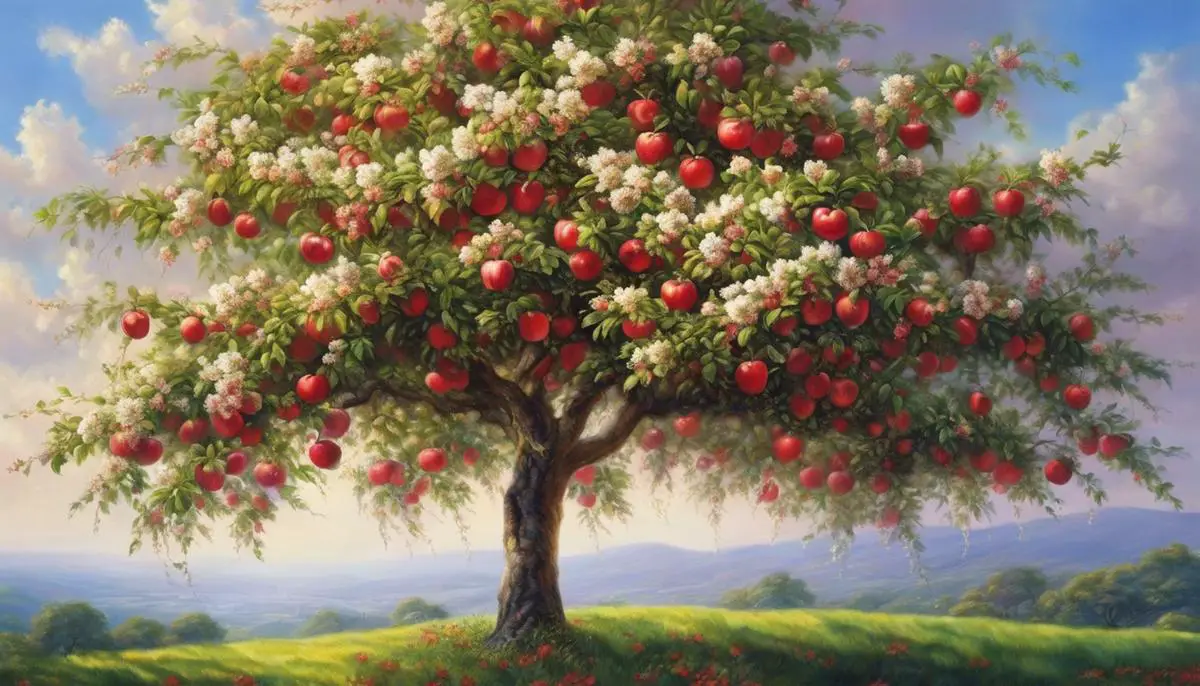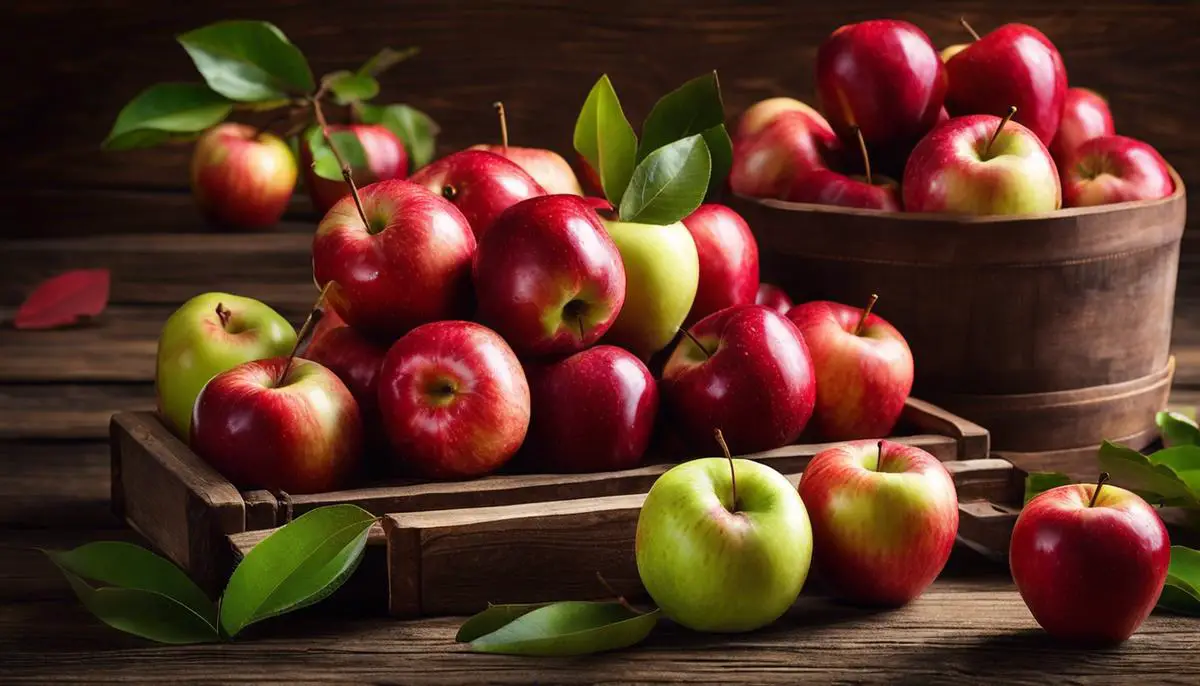Appreciating the true beauty and usefulness of the Paradise Apple Tree begins with understanding its rich history, unique characteristics, and fascinating backstory. Originating from the far-flung corners of Asia and journeying all the way to North America, this extraordinary species of apple holds a captivating legacy. Endearingly referred to as the ‘Paradise Apple’, it boasts a set of distinctive traits that clearly sets it apart from other apple variants. But the intrigue does not end there; the cultivation, maintenance, and yield of the Paradise Apple Tree warrant equal interest. By delving into specifics such as the best planting practices, recognizing the optimal harvest time, and exploring the broad range of applications of these small yet packed apples, understanding the full charm of the Paradise Apple Tree awaits.
Understanding the Paradise Apple Tree
A Slice of Heaven: The Unique Paradise Apple Tree
If the tale of Eden tickles the fancy, wait till the introduction to the Paradise Apple Tree. For the utmost apple enthusiasts, this tree is a firm favorite. Why, you ask? Let’s take a brief glance at its distinctive traits, history, and roots.
Imagine being able to grow an apple tree not more than six feet tall, bearing a bountiful crop of flavorful apples! The intriguing and distinct about the Paradise Apple tree, also known as the Malus pumila Mill, isn’t just its delightful fruit. Its relatively small stature makes it an endearing spectacle in any backyard orchard. The compact size is significant, mainly for those with limited space, but still have a burning desire to take a bite off of self-grown apples.
People have cherished the Paradise Apple tree for its prolific fruitage, often loaded with clusters of little red or green apples that pack a surprising punch of crispness and tang. They’re quite a treat, eaten fresh or used in the making of cider. However, it’s essential to remember that they’re not considered a dessert apple.
Looking back over the annals of history, this tree isn’t a modern marvel. In fact, its roots reach back to Kazakhstan and the surrounding areas, thousands of years ago. The use of this tree as a rootstock for grafting, began in France during the 1500s. Named ‘Doucin,’ these stocks were believed to originate from wild dwarf apple trees in France and Italy. Furthermore, in the 1700s, Englishman Thomas Andrew Knight developed a paradise rootstock creating a ‘dwarfed’ apple tree.
Now, here’s where it gets exciting. The Paradise Apple tree migrated to the New World along with European immigrants. It rose to prominence in Virginia during the early 19th century. They gained popularity due to their adaptability and resistance to diseases — traits that, coupled with their small size, made them particularly suitable for backyards.
So, next time you’re out in your garden, imagine the opportunity to grow a piece of apple paradise right there. They’re unique, charming, and historic. Just remember, though small, these trees require regular pruning for proper fruit formation. So, caring for a Paradise Apple Tree might be less effort than a regular tree, but no less attention and love.
Explore the world of the Paradise Apple tree; who knows, you might become their next biggest fan. Remember, as Voltaire once said, “We must cultivate our garden,” and what better way to start than with a slice of paradise?

Planting and Nurturing a Paradise Apple Tree
Planting and Nurturing your Paradise Apple Tree: A Detailed Guide
Planting a Paradise Apple Tree can be a fulfilling and intriguing hobby that rewards you with incredible results. This tree not only serves as an attractive element in your garden but also provides tasty fruits, serving as an addition to your garden’s ecosystem.
The first step towards successfully planting your Paradise Apple Tree begins with understanding its needs. Start by selecting the right site. This tree loves a sunny, well-drained location. It would do best if you chose a spot that receives at least six hours of sunlight each day.
Proper spacing plays a crucial role in a tree’s growth. Typically, your Paradise Apple Tree needs space of about 15 feet apart from other trees. Keep in mind this tree loves to spread its roots. With this space, your tree will have ample room to grow and flourish without competition for nutrients and water.
Soil is another essential consideration. The Paradise Apple Tree prefers well-draining soil, enriched with organic matter. This helps in improving the soil’s water retention, ensuring your tree gets enough moisture for growth. Additionally, a soil pH level of around 6.0-7.0 works best for this tree.
After deciding on the right site and soil, it’s time to plant your tree. It’s best to plant in late winter or early spring. Start by digging a hole that’s twice as wide and just as deep as your tree’s root ball. It helps the roots spread out easily in the initial stages of growth.
When it comes to watering, remember the Paradise Apple Tree is reasonably drought tolerant but appreciates regular watering. A balanced watering routine— not too much and not too little, keeps your tree robust. It’s also advised to water deeply and infrequently rather than often and in small quantities.
For your Paradise Apple Tree to grow successfully, occasional pruning is necessary. Pruning in late winter/early spring helps promote new growth. Remove dead or diseased branches and the ones growing inwards, creating a sturdy, open structure that allows light and air to flow freely.
You’ll also want to feed it, using a slow-release, all-purpose garden fertilizer in early spring before the new growth begins. An annual application should be enough. And be sure not to overfertilize as it can harm the tree.
The process of planting and nurturing a Paradise Apple Tree may seem extensive, but the rewards are abundant. With consistent care and attention, you’ll watch your tree thrive, providing tasty fruits and adding unrivaled beauty to your garden. So, as you venture into your apple-growing journey, always remember, patience is key. With each passing season, the rich reward of succulent Paradise Apples will be undoubtedly worth it. Happy planting!

Harvesting and Using Paradise Apples
Now that we have gone over the introductions and the meticulous care of the Paradise Apple Tree, it’s time to talk about the when and how of harvesting these vibrant little fruits, alongside their various uses.
Harvesting Paradise Apples is a joyous affair, typically taking place anytime from September through November, depending on the climatic conditions. The trick is to keep an eye on the apples for signs of ripeness. They are ready to be picked when they capably disconnect from the tree with a simple twist of the stem. Be prepared: Paradise Apples are relatively small in size, so it might take a couple of pickings to gather a substantial amount!
The method of harvesting is simple and needs careful attention. When they’re ready, the apples are plucked carefully to avoid bruising. The collected fruits are then sorted based on their condition. Undamaged ones are ideal for storage, and ones with minor blemishes are great for immediate use.
This brings us to the ‘What can you do with Paradise Apples?’ part. For those unacquainted, Paradise Apples are not just ornamental nuggets. They have a wide range of applications that can delight any hobbyist.
One of the most popular uses of Paradise Apples is in making jellies, jams or fruit preserves. Their sharp taste and firm texture make a fantastic ingredient in these homemade delights. Applesauce, another common use, is a heartwarming dish to consider. The unique, tangy-sweet taste of Paradise Apples adds a fantastic flavor that instantly uplifts any recipe.
Don’t dismiss the power of a beautifully baked Paradise Apple pie either. Its magnificent blend of sweetness and slight tartness creates an ethereal pie experience one won’t soon forget.
Of course, the apples can also be consumed as they are, fresh off the tree, making them a wonderful, healthy snack. For the decor enthusiast, a bowl of autumnal Paradise Apples adds an inviting touch to any design or centerpiece on a dining table, mantelpiece, or kitchen top.
Paradise Apple ciders are not left out, revealing the true essence of this specialty apple in a refreshing, unique drink. Finally, the trees also produce scintillating white flowers that can add oomph to any garden or yard.
In conclusion: whether it’s for the pot or the table, to drink or to store, the Paradise Apple is a unique hobbyist’s delight. Embrace the joy of harvesting these tiny wonders, while also exploring their multiple uses that extend far beyond mere consumption. Good luck with picking!

Its transcultural journey, distinct features, and versatile uses give the Paradise Apple Tree an unparalleled appeal among apple varieties. Their small, often vibrant fruit is a welcome addition to various culinary delights, from jams to ciders, even serving as a unique decorative feature. Planting and nurturing your own tree brings an intimate understanding and appreciation for this splendid variety. Having delved into the idiosyncrasies of selecting the right planting site, mastering the guidelines to foster soil health, tackling pests and illnesses, and finally, to reaping its bountiful harvest, you have gained a broader, more informed understanding of this extraordinary plant. The Paradise Apple Tree indeed lives up to its heavenly namesake, proving to be a fascinating subject of exploration in the robust and diverse world of apples.